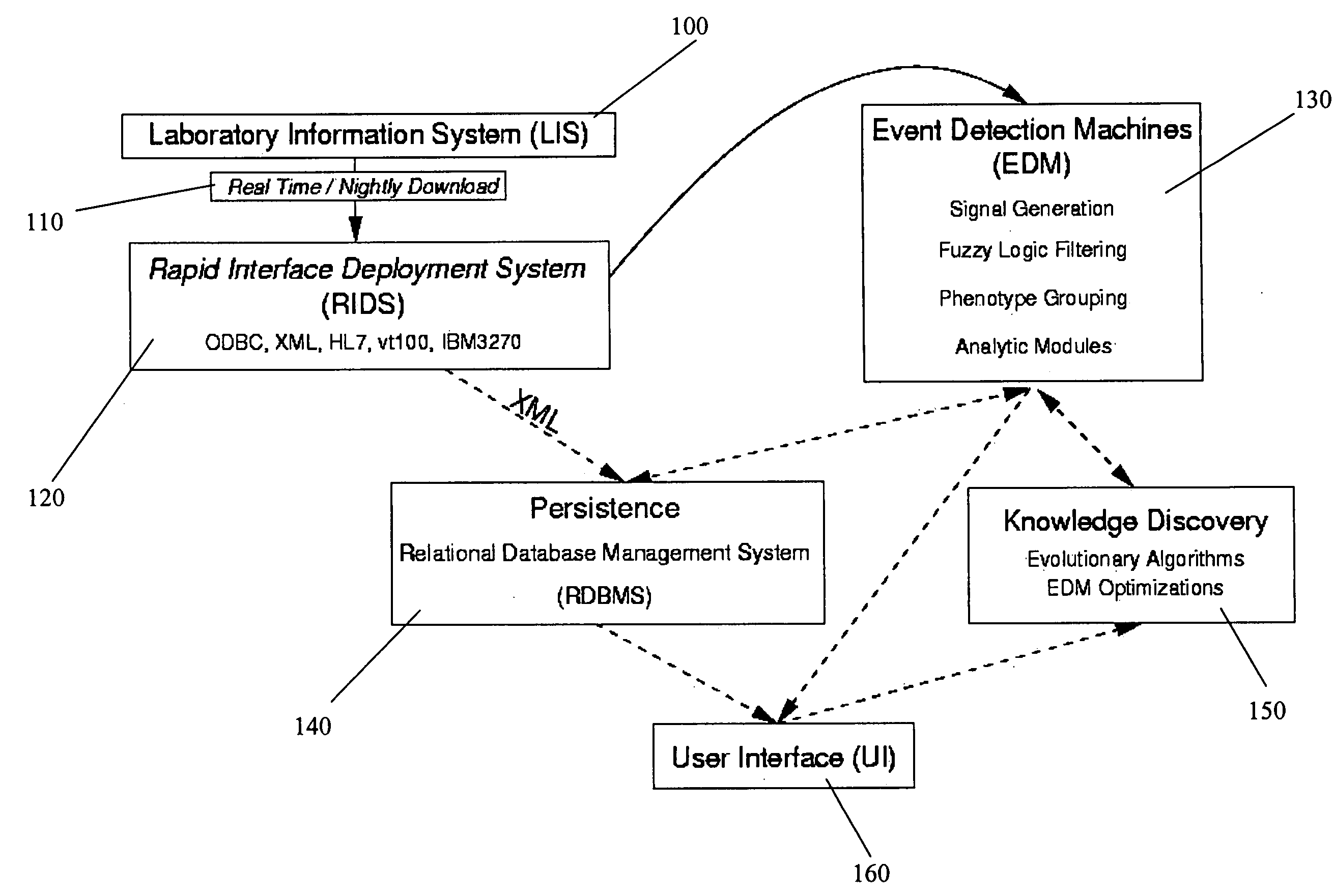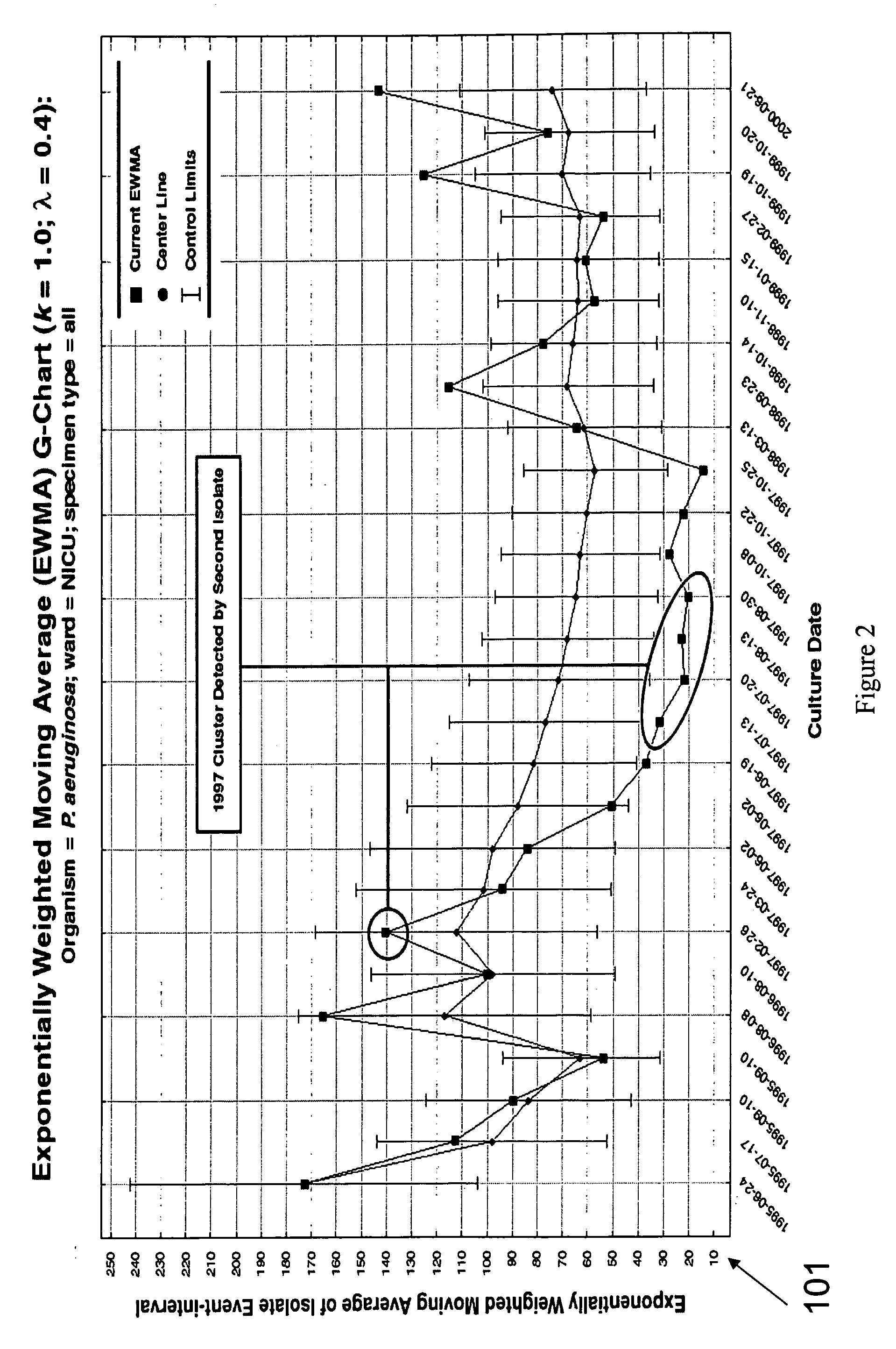System, method, and software for automated detection of predictive events
a technology of automatic detection and events, applied in the field of automatic detection system and method of detecting predictive events, can solve the problemswasting medical resources, and affecting the treatment effect of patients, and achieving the effects of reducing the number of infections, and improving the quality of li
- Summary
- Abstract
- Description
- Claims
- Application Information
AI Technical Summary
Benefits of technology
Problems solved by technology
Method used
Image
Examples
example 1
See FIG. 2—EWMA G-Chart
[0162] This Example utilized well-characterized data sets to certain embodiments of the present invention.
[0163] All inpatient microbiology results were extracted for the period Jan. 1, 1995 to Oct. 1, 2000 from the Children's Hospital Clinical Data Repository via BacLink into WHONET. Using infection control records, all outbreaks for which isolate strains had demonstrated genotypic identity were selected. Three datasets of the organisms of interest were generated, and each data set was analyzed using the present invention in an attempt to detect the following outbreaks:
[0164] Outbreak 1 (O1): An outbreak of Pseudomonas aeruginosa (“PAE”) in the neonatal intensive care unit (“NICU”) occurred during July and August 1997. There were five cases of rapidly progressive sepsis syndrome caused by isolates of a single genotype, which matched that of a healthcare worker with intermittent otitis extema. Four cases were fatal.
example 2
[0181] We currently have five years (30,000 isolates) of clinical microbiology data from Children's hospital and three years (17,000 isolates) from Beth Israel Deaconess Medical Center.
[0182] This Example attempts to discover and catalog a high percentage of the total number of actual outbreaks found in the data. In addition, the present Example uses various techniques to exhaustively characterize the outbreaks by enumerating the specific isolates pertaining to each.
[0183] The previously investigated events that have already been discovered, but not exhaustively characterized, are presented in Table 2. Several other techniques are used to discover additional outbreaks in all data sets. Experts exhaustively review the data sets using previously published and validated approaches. Stelling et al., 24(Suppl. 1)CLIN. INFECT. DIS. 157-68 (1997); Boyce et al., 161(3) J. INFECT. DIS. 493-39 (1990); O'Brien et al., Banbury Report 24 (Cold Spring Harbor Laboratory (1987). In addition, the ...
example 3
[0187] This Example presents a one year real-time surveillance trial. In preparation for the trial, five years of microbiology data from each hospital is fully characterized: collect and pre-process data, detect a sufficient number of events, exhaustively characterize those events, set up the Linux cluster, and build the EA framework. Those data sets are used by two types of EAs, early detection, and minimal association.
[0188] A HIPAA-compliant system is installed at one or more hospitals. In conjunction with experts, a survey is developed and administered to the ICPs at each of the three system sites. The survey attempts to quantify the ICP's ability to detect outbreaks and intervene in a timely manner for the year. The survey is completed by the ICPs both before the start of the system trial, at six months, and at the end. Results from the survey are used to quantify and validate the ability of the system to aid the ICPs in their work.
[0189]FIG. 6 illustrates the components of a...
PUM
 Login to View More
Login to View More Abstract
Description
Claims
Application Information
 Login to View More
Login to View More - R&D
- Intellectual Property
- Life Sciences
- Materials
- Tech Scout
- Unparalleled Data Quality
- Higher Quality Content
- 60% Fewer Hallucinations
Browse by: Latest US Patents, China's latest patents, Technical Efficacy Thesaurus, Application Domain, Technology Topic, Popular Technical Reports.
© 2025 PatSnap. All rights reserved.Legal|Privacy policy|Modern Slavery Act Transparency Statement|Sitemap|About US| Contact US: help@patsnap.com



